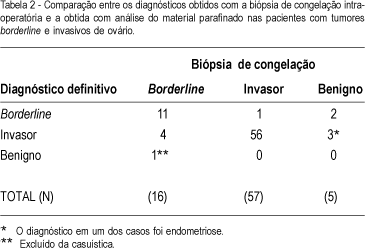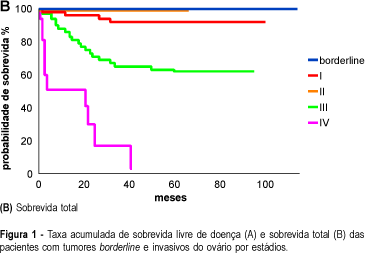Purpose: to determine some epidemiological, diagnostic and prognostic aspects in women with borderline and invasive epithelial ovarian tumors. Methods: the charts of 198 women treated at CAISM/UNICAMP from 1986 to 1996 were revised. For statistical assessment, chi², Fisher's exact and t Student's tests were used when appropriate, followed by survival curves by the Kaplan-Meyer method, compared by the log-rank test. The mean follow-up was 50 months (11 to 168). Results: the overall rate of borderline tumors was 12% (24 cases), and for invasive carcinoma, 88% (174 cases). The mean age of the patients with borderline tumors was significantly lower than that of those with invasive carcinoma (43 ± 14.8 years vs. 52 ± 12.6 years, p<0.002). The most frequent histologic types were the serous (81 cases: 41%) and the mucinous (46 cases: 23%) tumor. The women with borderline tumors had their diseases diagnosed in earlier stages when compared with the invasive carcinoma patients (p<0.0001). The frozen biopsy, performed on 77 patients, showed a high agreement with the paraffin fixed tissue in the invasive carcinoma cases. However, in borderline tumors, the rate of failure was higher (13%) and the major rate of failure was in mucinous tumors. Regarding prognosis, the survival rate was significantly higher in borderline tumors (p<0.001). Conclusions: women with epithelial ovarian tumors were younger, presented the disease at earlier stages, and had a better prognosis when compared with those with invasive carcinoma.
Ovarian neoplasia; Epidemiology; Borderline tumors





